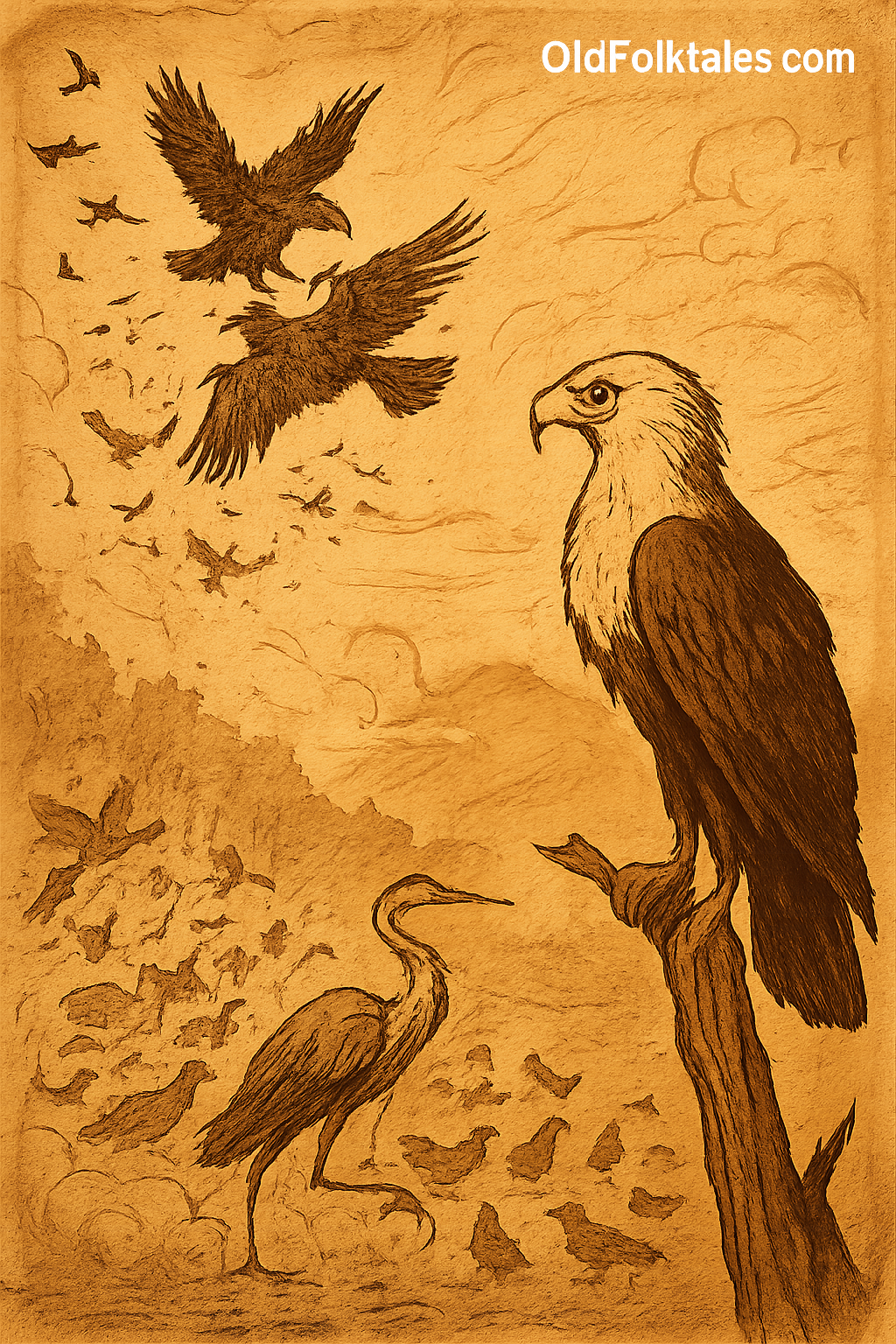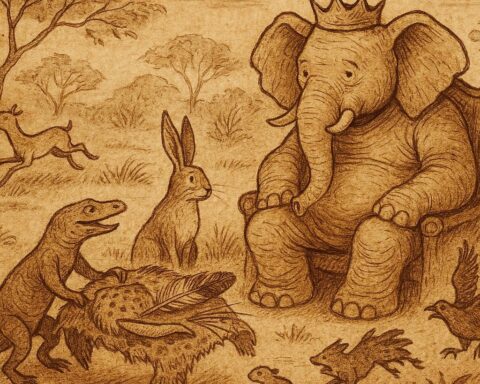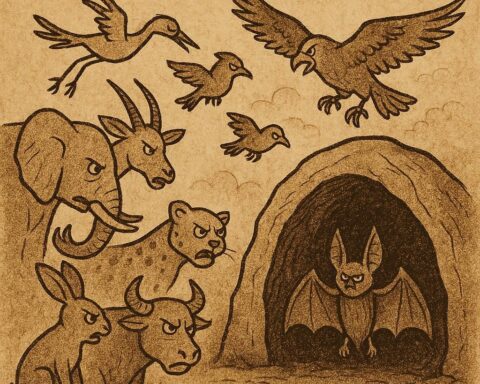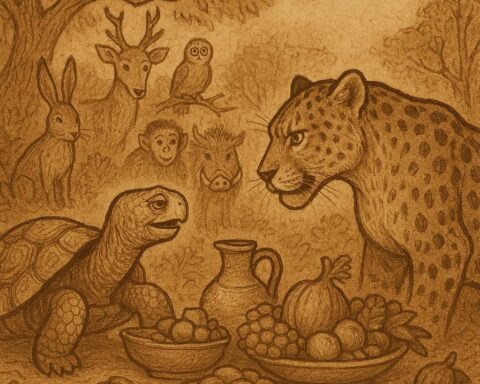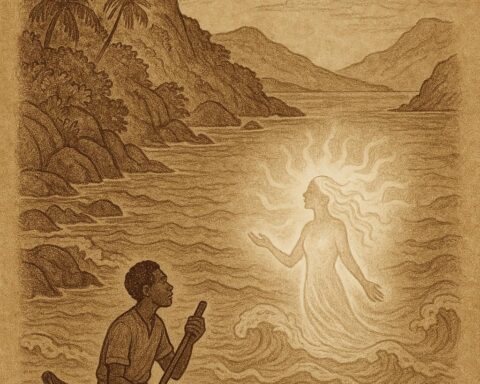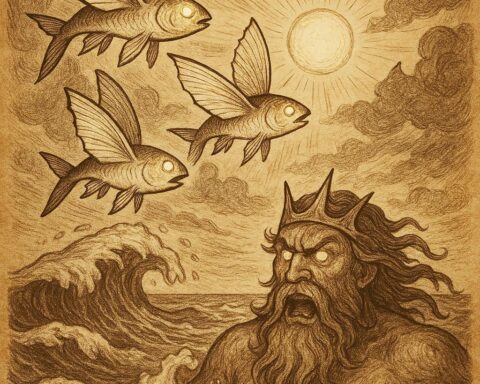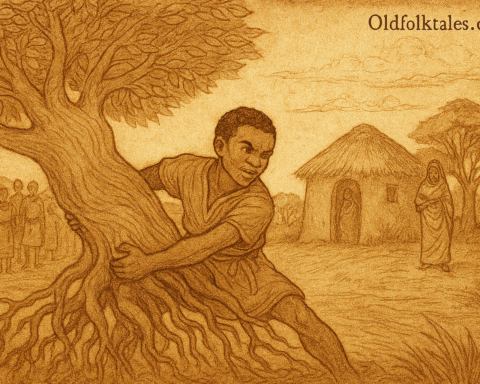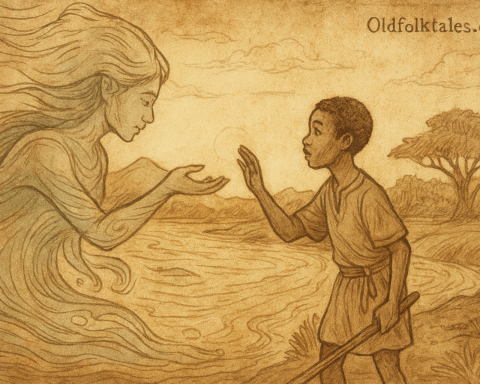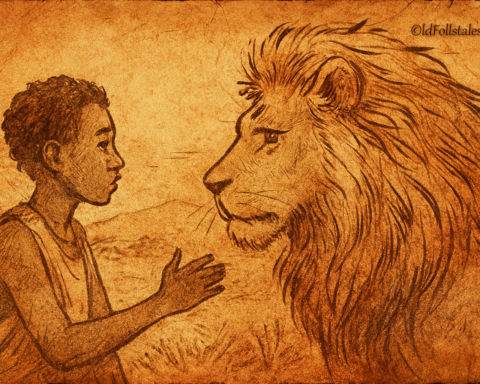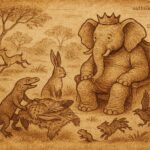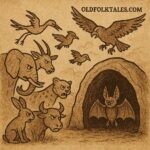In the ancient city of Old Town, Calabar, where the mighty Cross River flows toward the Atlantic Ocean and palm trees sway in the humid coastal breeze, there once ruled a king named Essiya. Like many of the great Calabar monarchs of bygone eras, King Essiya possessed immense wealth and wielded considerable power throughout his realm. His treasury overflowed with cowrie shells, his storehouses bulged with yams and palm oil, and his influence extended far beyond the city’s walls into the surrounding forests and waterways.
Despite his great riches, King Essiya faced one persistent challenge, he did not own many slaves to assist with the countless tasks required to maintain his prosperous kingdom. Rather than allow this limitation to hinder his realm’s progress, the wise king devised an ingenious solution. He called upon all the creatures of the land, water, and sky to contribute their unique talents to the wellbeing of his people.
Understanding that such a vast undertaking required proper organization and leadership, King Essiya decided to appoint head chiefs among all the different species of animals. This systematic approach would ensure that work was completed efficiently and that every creature understood its role in supporting the kingdom’s prosperity.
Also read: The King Adam’s Test
The process began with the land animals. After careful consideration of their various strengths and characteristics, King Essiya appointed the mighty elephant as king of all forest beasts. The elephant’s wisdom, strength, and natural leadership made him the perfect choice to govern the countless species that roamed through the dense tropical forests surrounding Calabar.
Next came the water creatures. The king selected the massive hippopotamus to rule over all aquatic animals, from the smallest fish to the largest crocodiles that basked along the riverbanks. The hippo’s dominance in both water and on land made him an ideal leader for the diverse community of river and coastal creatures.
Finally, it came time to select a ruler for the birds, and this decision proved far more complex than King Essiya had anticipated. As he sat in his royal court, surrounded by carved ivory tusks and colorful woven cloths, the king found his mind overwhelmed by the sheer variety of winged creatures in his domain, each seemingly qualified for leadership in their own unique way.
There were the hawks, swift and fierce, with their razor-sharp talons and keen eyesight that could spot prey from incredible distances. Among the hawk family alone, numerous species existed—the large red-tailed hawks that soared majestically over the forests, the smaller but equally deadly sparrowhawks, and the massive martial eagles that commanded respect wherever they flew.
The wading birds presented their own compelling case for leadership. The elegant herons stood motionless in the shallows like living statues, demonstrating patience and precision in their hunting techniques. The enormous spur-winged geese moved in perfect formations across the sky, showing remarkable coordination and discipline.
From the forest depths came the claims of the hornbill and toucan tribes, their massive beaks and vibrant plumage making them impossible to ignore. These spectacular birds served important roles in the forest ecosystem, dispersing seeds and maintaining the delicate balance of life in the canopy.
The game birds—guinea fowl with their spotted feathers and loud calls, secretive partridges that preferred the shadows, and the impressive bustards that commanded attention with their size—all submitted their petitions to be considered for the royal position.
The crane tribe added another layer of complexity to the decision. These magnificent birds, with their long legs and graceful necks, were regular visitors to the sandbanks during the dry season, performing elaborate dances and filling the air with their haunting calls. However, they mysteriously disappeared when the river waters rose, making their reliability as year-round leaders questionable.
Soaring high above all the other candidates were the black-and-white fishing eagles, powerful raptors whose piercing cries echoed across the waterways as they dove with incredible precision to snatch fish from the river’s surface.
The smaller birds were not to be overlooked either. The plover tribe, with their intricate patterns and varied calls, claimed expertise in shoreline management. Seabirds, including the impressive pelicans with their enormous pouches, argued for their mastery of coastal territories. Even the gentle doves and the countless shy forest birds emerged from their hidden perches to submit their claims for consideration.
As petition after petition arrived at the royal court, King Essiya found himself increasingly confused and overwhelmed by the complexity of his decision. Each species presented valid arguments, and choosing one over all the others seemed impossible without causing resentment and discord among his feathered subjects.
After days of contemplation, the king reached a bold decision. Rather than attempting to choose the worthiest candidate himself, he would allow the birds to determine their own leader through a trial by combat. He sent royal messengers throughout his kingdom, announcing that all birds should gather the following day for a great contest, and that the victor would be proclaimed king of all birds for all time.
The appointed morning arrived with spectacular fanfare. Thousands upon thousands of birds descended upon the great clearing outside Calabar, creating a cacophony of calls, screeches, and songs that could be heard for miles in every direction. The very sky seemed to darken with the multitude of wings, and the air vibrated with the energy of so many creatures gathered in one place.
The contest began immediately, but it quickly became apparent that brute force would play a significant role in determining the outcome. The aggressive hawk tribes wasted no time in attacking the smaller birds, driving away the delicate forest dwellers and terrorizing the timid species until they fled in panic back to their hidden roosts.
The large wading birds, despite their impressive size, found themselves unable to cope with the hawks’ aerial superiority and speed. The herons and cranes, built for patient stalking rather than aerial combat, soon retreated to the safety of distant marshlands.
The spur-winged geese made a valiant effort, honking loudly and attempting to use their formation-flying skills to their advantage, but they too were eventually overwhelmed by the hawks’ relentless attacks. In a spectacular display that looked like an aerial version of “Follow the Leader,” the entire goose tribe departed in a long, straight line, their calls fading into the distance.
The forest birds, accustomed to the quiet, secluded life beneath the canopy, quickly grew tired of the noise and chaos. After emitting a few croaks, strange calls, and other peculiar sounds that served as their formal withdrawal from the competition, they disappeared back into their familiar woodland sanctuaries.
The game birds never stood a chance against the aerial combatants. Guinea fowl, partridges, and bustards quickly sought refuge in the thick underbrush, their land-based strengths proving useless in this sky-bound battle.
As the dust settled and the weaker competitors fled, only two groups remained: the various hawk species and one solitary black-and-white fishing eagle who had been calmly observing the entire spectacle from his perch in a tall mahogany tree.
The scavenger hawks, bloated and lazy from their diet of carrion, showed little interest in the proceedings and were quietly ignored by their more aggressive cousins. The fighting hawks continued their battle with renewed intensity, circling higher and higher into the sky, their whistling calls growing fainter as they disappeared from view.
The combat was fierce and relentless. Hawks would periodically return to earth, many bearing wounds from the battle—torn feathers, scratched faces, and exhausted wings telling the story of their brutal aerial warfare.
Throughout this chaos, the fishing eagle remained motionless on his perch, his keen yellow eyes taking in every detail of the combat below. His black and white plumage gleamed in the sunlight, and his massive talons gripped the branch with casual strength that spoke of immense power held in reserve.
Finally, when the hawk tribes had exhausted themselves with their futile combat, the fishing eagle spoke in a voice that carried clearly across the battlefield:
“When you have quite finished with this foolishness, please inform me. And if any of you still fancy your chances at being elected head chief, come to me now, and I will settle your prospects once and for all.”
The remaining hawks looked up at the fishing eagle, taking in his enormous hooked beak, designed for tearing apart the toughest fish, and his cruel-looking talons that could crush bones with ease. They had all heard stories of his incredible strength and legendary ferocity in battle. The fishing eagle’s reputation as a hunter was unmatched—he could dive from great heights at tremendous speed, snatch large fish from the water’s surface, and carry prey nearly as heavy as himself back to his nest.
Faced with this display of quiet confidence and obvious physical superiority, the hawks ceased their fighting among themselves and unanimously acknowledged the fishing eagle as their master and superior.
King Essiya, who had been watching the entire contest from his royal platform, rose and made the official proclamation. He declared that Ituen for that was the fishing eagle’s name would henceforth be recognized as the head chief of all birds and would bear the title of King Bird for all generations to come.
From that historic day forward, a powerful tradition emerged in Calabar and spread throughout the surrounding regions. Whenever young warriors prepared for battle, they would carefully select three of the long, distinctive black-and-white feathers from the king bird, one feather to be worn on each side of their head, and one in the center. These sacred feathers were believed to transfer the fishing eagle’s legendary courage, strength, and skill to the wearer.
The tradition became so deeply ingrained in the culture that any young man who ventured into combat without these precious feathers was considered unprepared and was looked upon with pity, regarded as nothing more than a small boy attempting to play at being a warrior. The feathers of Ituen, the King Bird, had become symbols of true strength, wisdom, and the divine right to lead.
The Moral of the Story
This powerful Nigerian tale teaches us that true leadership comes not from aggression or empty boasting, but from quiet confidence, wisdom, and the strength to act decisively when the moment demands it. The fishing eagle’s victory demonstrates that the greatest leaders often observe carefully before acting, and that sometimes the most impressive display of power is restraint until action becomes necessary.
Knowledge Check
Q1: What role does King Essiya play in this Nigerian folktale’s exploration of leadership? A: King Essiya represents wise governance through delegation and fair competition. His decision to let the birds choose their own leader through combat reflects traditional African values of merit-based leadership and the importance of proving oneself worthy of authority through demonstration rather than appointment.
Q2: How does the fishing eagle’s strategy differ from the other birds’ approaches to winning leadership? A: While the other birds engaged in chaotic fighting and exhausted themselves, the fishing eagle demonstrated patience, observation, and strategic thinking. His quiet confidence and willingness to wait until the right moment reflects traditional African leadership values of wisdom over impulsiveness.
Q3: What is the cultural significance of warriors wearing the king bird’s feathers in Nigerian tradition? A: The feathers represent the transfer of the fishing eagle’s courage, strength, and leadership qualities to human warriors. This practice reflects the African belief in the spiritual connection between humans and animals, and how the qualities of powerful creatures can be channeled through sacred objects.
Q4: How does the elimination process in the bird contest reflect natural hierarchies in African storytelling? A: The systematic elimination of different bird groups reflects the natural order where physical prowess, strategic thinking, and leadership qualities determine hierarchy. This mirrors traditional African understanding of how natural selection and merit-based systems create effective leadership structures.
Q5: What does the fishing eagle’s final challenge to the hawks reveal about effective leadership communication? A: The fishing eagle’s direct, confident challenge demonstrates that true leaders communicate with authority and clarity. His ability to end the conflict with words backed by obvious strength shows that effective leadership combines diplomatic skills with the power to enforce decisions when necessary.
Q6: How does this Nigerian folktale reflect traditional African values about proving worthiness for leadership roles? A: The story emphasizes that leadership must be earned through demonstrated capability rather than inherited or appointed arbitrarily. The fishing eagle’s victory through a combination of patience, strategic thinking, and superior strength reflects African cultural values that honor merit-based authority and respect for natural hierarchies.
Source: Traditional Nigerian folktale, Calabar region
